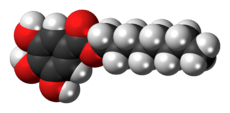Octyl gallate
 | |
 | |
| Names | |
|---|---|
| IUPAC name
Octyl 3,4,5-trihydroxybenzoate | |
| Other names
E311; Progallin O; n-Ocyl gallate; Stabilizer GA-8; Gallic acid octyl ester; 3,4,5-Trihydroxybenzoic acid octyl ester | |
| Identifiers | |
| 1034-01-1 | |
| 3D model (Jmol) | Interactive image |
| ChEBI | CHEBI:83631 |
| ChEMBL | ChEMBL277346 |
| ChemSpider | 55194 |
| ECHA InfoCard | 100.012.594 |
| EC Number | 213-853-0 |
| E number | E311 (antioxidants, ...) |
| PubChem | 61253 |
| UNII | 079IIA2811 |
| |
| |
| Properties | |
| C15H22O5 | |
| Molar mass | 282.34 g·mol−1 |
| Appearance | White solid[1] |
| Melting point | 98 to 101 °C (208 to 214 °F; 371 to 374 K)[1] |
| Hazards | |
| R-phrases | R22-R43[1] |
| S-phrases | S24-S37[1] |
| Except where otherwise noted, data are given for materials in their standard state (at 25 °C [77 °F], 100 kPa). | |
| | |
| Infobox references | |
Octyl gallate is the ester of 1-octanol and gallic acid. As a food additive it is used under the E number E311 as an antioxidant and preservative.
Properties
Octyl gallate is a white powder with a characteristic odor. It is very slightly soluble in water and soluble in alcohol. Its solubility in lard is 1.1%. Octyl gallate darkens in presence of iron.
Uses
This antioxidant is used in numerous cosmetics and pharmaceutical, cosmetic, and food products such as soaps, shampoos, shaving soaps, skin lotions, deodorants, margarine, and peanut butter.
It is a synergistic antioxidant with butylated hydroxytoluene (BHT) and butylated hydroxyanisole (BHA).
References
- 1 2 3 4 Octyl gallate at chemicalland21.com
This article is issued from Wikipedia - version of the 8/10/2016. The text is available under the Creative Commons Attribution/Share Alike but additional terms may apply for the media files.